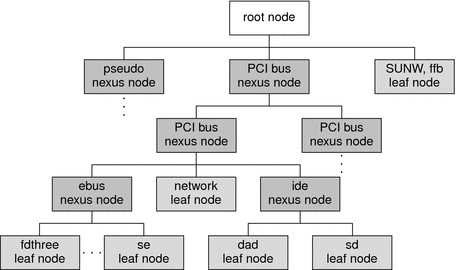Device Tree Components
The system builds a tree structure that contains information about the devices connected to the machine at boot time. The device tree can also be modified by dynamic reconfiguration operations while the system is in normal operation. The tree begins at the root device node, which represents the platform.
Below the root node are the branches of the device tree. A branch consists of one or more bus nexus devices and a terminating leaf device.
A bus nexus device provides bus mapping and translation services to subordinate devices in the device tree. PCI - PCI bridges, PCMCIA adapters, and SCSI HBAs are all examples of nexus devices. The discussion of writing drivers for nexus devices is limited to the development of SCSI HBA drivers (see Chapter 18, SCSI Host Bus Adapter Drivers).
Leaf devices are typically peripheral devices such as disks, tapes, network adapters, frame buffers, and so forth. Leaf device drivers export the traditional character driver interfaces and block driver interfaces. The interfaces enable user processes to read data from and write data to either storage or communication devices.
The system goes through the following steps to build the tree:
-
The CPU is initialized and searches for firmware.
-
The main firmware (OpenBoot, Basic Input/Output System (BIOS), or Bootconf) initializes and creates the device tree with known or self-identifying hardware.
-
When the main firmware finds compatible firmware on a device, the main firmware initializes the device and retrieves the device's properties.
-
The firmware locates and boots the operating system.
-
The kernel starts at the root node of the tree, searches for a matching device driver, and binds that driver to the device.
-
If the device is a nexus, the kernel looks for child devices that have not been detected by the firmware. The kernel adds any child devices to the tree below the nexus node.
-
The kernel repeats the process from Step 5 until no further device nodes need to be created.
Each driver exports a device operations structure dev_ops(9S) to define the operations that the device driver can perform. The device operations structure contains function pointers for generic operations such as attach(9E), detach(9E), and getinfo(9E). The structure also contains a pointer to a set of operations specific to bus nexus drivers and a pointer to a set of operations specific to leaf drivers.
The tree structure creates a parent-child relationship between nodes. This parent-child relationship is the key to architectural independence. When a leaf or bus nexus driver requires a service that is architecturally dependent in nature, that driver requests its parent to provide the service. This approach enables drivers to function regardless of the architecture of the machine or the processor. A typical device tree is shown in the following figure.
Figure 2–2 Example Device Tree

The nexus nodes can have one or more children. The leaf nodes represent individual devices.
- © 2010, Oracle Corporation and/or its affiliates
